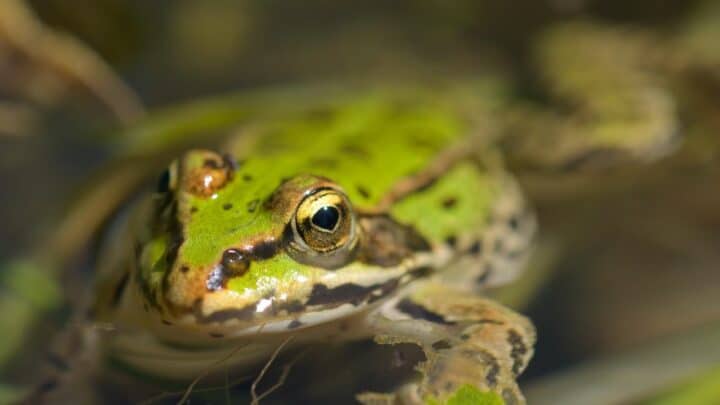Just like humans and all other animals, frogs rely on water to survive. More so, if you consider that their skin needs to remain moist at all times and that they need watery environments to lay their eggs.
Have you ever wondered how frogs drink water? Read on to find out.
How Frogs Drink Water
Frogs do not consume water using their mouths. Instead, they absorb water via a semi-permeable area of their skin known as a drinking patch, located on the underside of their thighs and their abdomens. This process is known as osmosis whereby water passes through a frog’s permeable skin.
Osmosis and How it Helps Frogs Hydrate
Frogs absorb water through their skin passively, rather than having to drink it actively. Water moves in and out of their bodies as needed through the process of osmosis.
Osmosis is a balancing act that dictates water to move from high to low concentrations.
In the case of frogs, the permeable membrane of their drinking patches is what allows for this process to occur.
Given this, it is fair to say that frogs don’t exactly drink water, as we understand other animals consume water. Even so, they are utterly reliant on it for their survival.
During the osmotic cycle, they absorb not only water but also various salts and oxygen.
This can be quite a risky business for frogs. Because they absorb water through their skin, they are far more susceptible to toxins and water pollutants.
Frogs will only thrive in environments where their water is clean and safe.
How Osmosis Works for Freshwater Frogs
The salt content of freshwater frogs’ bodies is generally much higher than the water source they inhabit.
Therefore, just as osmosis increases the density of water in their bodies, it also dilutes the salt content to create a perfect balance.
Conversely, frogs that are adapted to brackish water perform this process in reverse. An increase of urea in their bodies aids them in coping with higher salt levels, while special glands work to prevent excess salt from entering their systems through their skin.
Too much exposure to salty water can dry them out and cause harmful water loss.
How Osmosis Works for Domestic Frogs
Any proud frog parent will tell you that access to clean water is just as crucial to a frog’s wellbeing as food and temperature control.
In a home environment, frogs require a water dish large enough for them to submerge their undercarriages. The tiny pores in their permeated skin will soak up the water and salts they need to remain healthy.
As there are no hard and fast rules regarding how much water domestic frogs absorb, it’s best to ensure they always have access to fresh water in their bowls.
Frog breeders and hobbyists will more than likely be able to assist you with researching specific breeds.
For land-dwelling frogs, a shallow dish will suffice. Frogs of aquatic species require greater contact with water spread over a larger surface area.
Frogs are very sensitive and susceptible to chlorine, so opt for bottled water or rainwater over tap water if possible and clean their bowls at least once a day, without using chemicals.
As a side note, it’s a good idea to mist your frog enclosures regularly too. Amphibians thrive in humid environments, so a little bit of extra moisture goes a long way.
How Osmosis Helps a Frog to Breathe
Osmosis is a vital part of ensuring frogs are sufficiently hydrated, and just so, it is crucial to their breathing. Even though most frog species have fully functional lungs, they receive a lot of air through their skin too.
In water, frogs absorb the oxygen around them, which is then transmitted to their blood. When they are fully submerged underwater, this is literally how they breathe.
However, they also respire in this manner on land. Ever wondered why frogs are so slimy?
That’s why. Special glands produce a layer of mucus on the surface of their skin, which keeps the process of osmosis flowing when they’re on land.
Frequently Asked Questions about How Frogs Drink Water
Can frogs live outside of water?
Lots of frogs live both on land and underwater. Land-dwelling frogs do, however, need to be close to a water source at all times. For frogs to absorb oxygen, their skin must remain. Therefore, you’ll most often find large armies of frogs living close to swamps, dams, or lakes.
How long can a frog stay underwater?
Frogs can breathe through their skin as well as through their mouths and lungs, and so they fare relatively well underwater. Typically, they can survive fully submerged for 4 to 7 hours at a time.
What should I do when I find my frog dehydrated?
Rehydrating a frog is a sensitive process that requires great care. Place the frog’s lower end in a water-filled shallow dish. Make sure its head, eyes, and nose are not submerged. Handle the frog as little as possible. If the frog survives, make sure it has access to plenty of food while it recovers.
Conclusion
I find everything about frogs fascinating, and the way they consume water is just another testament to their incredible biological makeup.
The next time you see a slippery, slimy frog languishing in a pool of water, know that it’s probably having a drink.


